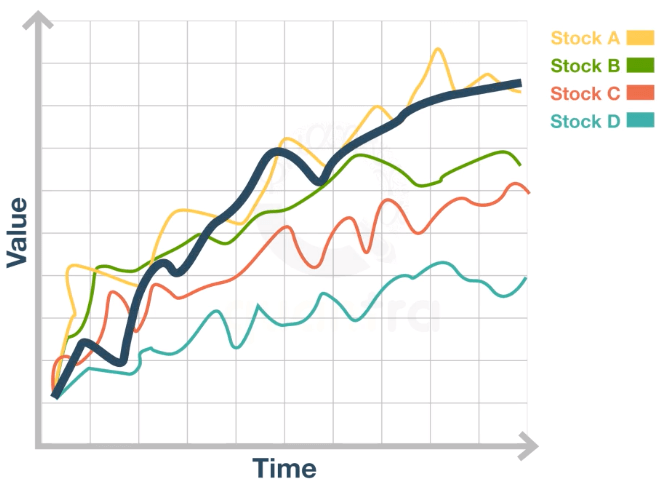Mutually exclusive events are the interesting occurrences that cease to exist at the same time. In this article, you will find out how these two or more mutually exclusive events take place in the financial market.
The blog covers:
- What are mutually exclusive events?
- Example of mutually exclusive events in trading
- Calculating mutually exclusive events
- Mutually exclusive events in the economy
- Difference between mutually exclusive events and independent events
- Example of an independent event in trading domain
What are mutually exclusive events?
Mutually exclusive events are those events that can not take place at the same time. For instance, you can not run backwards and forwards at the same time.
Tossing a coin is another example. You can not expect heads and tails in a single flip or event. Similarly, there are mutually exclusive events in the financial market trading practice.
Example of mutually exclusive events in trading
A very simple example of mutually exclusive events in financial markets trading can be explained including your budget and the value of different stocks at the same time.
Now, assume you want Stock A, Stock B, Stock C and Stock D in your portfolio. The stocks are shown below in the chart (with market index in black line) as the ones which have increased in value over time.

Example of mutually exclusive events in trading
Assume your budget is $1,000,000. Now, if:
- the price of Stock A is $90,000 per share, whereas
- Stock B is priced at $80,000 per share,
- Stock C and Stock D are priced at $50,000, per share each
The budget does not allow you to invest in all the stocks since you only have a limited capital to invest. Here, you can either invest in only Stock A or only Stock B. Or, you can invest in both Stock C and Stock D since they are not mutually exclusive.
It leads to these revelations:
With Stock A
- Stock A and Stock B – Mutually exclusive
- Stock A and Stock C – Mutually exclusive
- Stock A and Stock D – Mutually exclusive
With Stock B
- Stock B and Stock A – Mutually exclusive
- Stock B and Stock C – Mutually exclusive
- Stock B and Stock D – Mutually exclusive
With Stock C
- Stock C and Stock A – Mutually exclusive
- Stock C and Stock B – Mutually exclusive
- Stock C and Stock D – Not mutually exclusive
With Stock D
- Stock D and Stock A – Mutually exclusive
- Stock D and Stock B – Mutually exclusive
- Stock D and Stock C – Not mutually exclusive
The concept of mutually exclusive investments can also be driven by strategic considerations, where funds are directed toward those stocks that will allow you to most effectively pursue your desired investment.
Calculating mutually exclusive events
For calculating mutually exclusive events, probability can be used. Probability is considered the most commonly used practice in various fields such as finance, artificial intelligence, game theory, philosophy, etc.
In the case of probability, each mutually exclusive event has a possibility of occurring at least once. For instance, flipping a coin can either end in heads or tails and the probability of each occurring is 0.5 by applying this formula:
P(A) = Total number of favourable outcomes / Total number of possible outcomes
where, P(A) = probability
- Total number of favourable outcomes = 1 (either head or tails)
- Total number of possible outcomes = 2 (head and tails)
So, the Probability of either heads or tails is ½ or 0.5.
Okay, this was a simple explanation of probability. Now, in the case of mutually exclusive events, the probability of one of the events (one or more mutually exclusive events) occurring can be found out.
Mutually exclusive events in the economy
There can be some mutually exclusive events in the economy such as inflation and deflation. These two economic events can not occur at the same time. And, even if one of them occurs, say, inflation, then further events such as lower interest rates and an increase in the value of the dollar can not take place at the same time.
Therefore, these three events are mutually exclusive events since they can not take place together:
- Inflation
- Lower interest rates
- Increase in dollar value
Similarly, these three are mutually exclusive events and can not take place together:
- Deflation
- Higher interest rates
- Decrease in dollar value
Difference between mutually exclusive and independent events
Independent events are those which are not interrelated like mutually exclusive events. The table below shows the difference clearly:
| Independent events | Mutually exclusive events |
| No relation between two events but they can take place at the same time | These two events can not take place at the same time |
| For example, it is a sunny day (one event). I won the chess competition (another event) | For example, when you flip a coin, head and tail can not show up at the same time |
Example of an independent event in trading domain
Let us now take an example of an independent event to learn the difference between the two events better with the help of a technical indicator known as Relative strength index or RSI.
Relative strength index RSI is a momentum oscillator to indicate overbought and oversold conditions in the market. It oscillates between 0 and 100 and its values below a certain value, usually, 30 indicate an oversold market while values above another, say 70, indicate overbought conditions.
Typically, a look back period of 14 days is considered for its calculation and can be changed to fit the characteristics of a particular asset or trading style.
Visit QuantInsti for additional insight on this topic: https://blog.quantinsti.com/mutually-exclusive-events/.
Disclaimer: All data and information provided in this article are for informational purposes only. QuantInsti® makes no representations as to accuracy, completeness, currentness, suitability, or validity of any information in this article and will not be liable for any errors, omissions, or delays in this information or any losses, injuries, or damages arising from its display or use. All information is provided on an as-is basis.
Disclosure: Interactive Brokers
Information posted on IBKR Campus that is provided by third-parties does NOT constitute a recommendation that you should contract for the services of that third party. Third-party participants who contribute to IBKR Campus are independent of Interactive Brokers and Interactive Brokers does not make any representations or warranties concerning the services offered, their past or future performance, or the accuracy of the information provided by the third party. Past performance is no guarantee of future results.
This material is from QuantInsti and is being posted with its permission. The views expressed in this material are solely those of the author and/or QuantInsti and Interactive Brokers is not endorsing or recommending any investment or trading discussed in the material. This material is not and should not be construed as an offer to buy or sell any security. It should not be construed as research or investment advice or a recommendation to buy, sell or hold any security or commodity. This material does not and is not intended to take into account the particular financial conditions, investment objectives or requirements of individual customers. Before acting on this material, you should consider whether it is suitable for your particular circumstances and, as necessary, seek professional advice.











![[Gamma] Scalping Please [Gamma] Scalping Please](https://ibkrcampus.com/wp-content/smush-webp/2024/04/tir-featured-8-700x394.jpg.webp)



